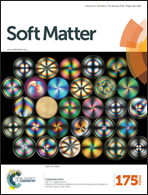Exploration of the nature of a unique natural polymer-based thermosensitive hydrogel
Abstract
The chitosan (CS)/β-glycerol phosphate (GP) system is a heat induced gelling system with a promising potential application, such as an injectable biomedical material. Unlike most thermosensitive gelling systems, the CS/GP system is only partially reversible. That is once the hydrogel is fully matured, it only softens but cannot go back to its initial liquid state when cooled down. Here, we perform both the small and large amplitude oscillatory shear (SAOS and LAOS) tests on the fully matured CS/GP hydrogel samples at a variety of temperatures within the cooling process. The purpose of such tests is to investigate the structural change of the hydrogel network and thus to understand the possible gelation mechanism of this unique thermosensitive hydrogel. From the LAOS results and the further analysis with the Chebyshev expansion method, it shows that the CS/GP hydrogel is composed of a colloidal network dominated by hydrophobic interactions at high temperature, and gradually turns into a flexible network dominated by hydrogen bonding when the temperature goes down. Therefore, we may conclude that LOAS is a powerful tool to study the nonlinear behaviour of a polymer system that is closely related to its structure, and as a practical example, we achieve a clearer vision on the gelation mechanism of the unique CS/GP thermosensitive hydrogel on the basis of considerable previous studies and assumptions in this laboratory and other research groups.


 Please wait while we load your content...
Please wait while we load your content...